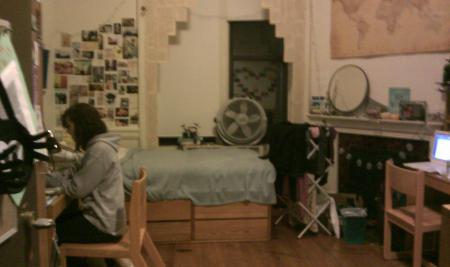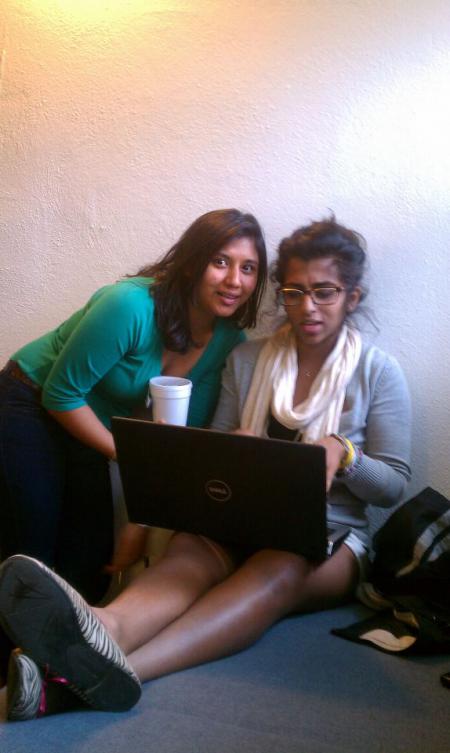Serendip is an independent site partnering with faculty at multiple colleges and universities around the world. Happy exploring!
Blogs

My Space
For this essay, the space I chose to write about was my dorm room. I spend most of my free time in the room, both studying and socializing. In this way, my space serves a dual purpose to meet both of my needs. The way I have decorated my room and they ways in which I use it indicate my goals for education at Bryn Mawr: to be a well-rounded student and maintain a balance between work and play. By comparing the image of my room to those we were shown by Jen Rajchel, I can see that the use of space, and thus students’ expectations for Bryn Mawr, have changed since M. Carey Thomas's time. In addition, I believe the class hierarchy that was connected with having more space and privacy no longer exists. The social aspect of college plays a pivotal role in my time spent here at Bryn Mawr, and unlike some of my predecessors, I am not ashamed of being labeled as lower class by my peers.

"Blue-Vested Vultures:" A Summer as a PPSP Clinic Escort
I was a patient escort for Planned Parenthood of Southeastern Pennsylvania (Westchester) the summer after my freshman year of college, and therefore related on a very personal level to one of the videos we watched for class this week. I'm from Massachusetts, where buffer zones are the law, so protestors cannot be within 35 feet of a family planning clinic. The situation at PPSP therefore shocked me. In the attached image, there is a white line in the lower-left hand corner. This was the line that protestors could not cross. It was literally a foot from the back of where the cars would pull in. As a result, when we walked in patients (most of whom were visiting Planned Parenthood for birth control, STD testing, or other preventive services), we would end up standing several feet from protestors screaming at us and the patients. Planned Parenthood has a non-engagement policy, so we were not to look at the protestors in the eye, nor respond to them, nor provoke them in any ways. I witnessed first-hand the racist tactics the protestors used to try to reach out to the patients: if someone looked remotely Hispanic, they would shout in broken Spanish ("el aborto mata!") African-Americans who entered the clinic were told that Planned Parenthood was conducting a Holocaust against black babies, specifically targeting black mothers.
A response to “Miss Representation 8 min. trailer:” Changing gender stereotypes by increasing visibility of female athletes
The trailer for Miss Representation by filmmaker Jennifer Siebel Newsom describes the power of the media, acknowledging that people learn more from it than any other single source of information. The media is the primary force that shapes our society: “politics, national discourse, and children’s brains, lives, and emotions” (Jim Steyer, CEO, Common Sense Media). Upwards of one billion people use the Internet every day (Marissa Mayer, Vice President, Consumer Products, Google); images are widely available and accessible without restrictions.
The messages disseminated by the mainstream media are pervasive, and more often than not emphasize and perpetuate harmful gender stereotypes. According to Miss Representation, women hold only 3% of clout positions in telecommunications, entertainment, publishing and advertising and comprise just 16% of all writers, directors, producers, cinematographers and editors. Because women are generally not the ones deciding how they are represented in the media, they are often shown as sex objects, valued by their looks rather than their achievements. As a result, “girls are taught that their value is based on how they look, and boys are taught that that’s what’s important about women” (Jean Kilbourne, EdD, Filmmaker, Killing Us Softly).


Intellectual Space and Privacy
I chose the nook and specifically the window seat as my location to examine. It is important to me because it has come to be the space where I spend the most of my time and slowly has come to be known as not just a public space for any Pem West 2nd residents, but as "my corner." I felt that this unconcious claiming of space was interesting especially because when thinking about the idea that privacy, even at Bryn Mawr, was a classed thing that had much to do with the amount of money that each student paid. I felt that I was breaking this previous connection between privacy and money, considering I am not the "ideal" student that Bryn Mawr was initially labeled for. At this same time, this spot makes me wonder about this institution at large, and I see here that money does indeed allow for greater intellectual space, as there are certain students who may not be able to afford the price of Bryn Mawr, and are as such, attending other institutions. Because I am here, claiming the space of the window seat, within this same institution, I wonder whether it is okay for me to be doing so, as I am not the white, upper class, rich student that Bryn Mawr College, as a space, was created for. It was this tension that made me want to further examine a place that I feel to be more of a home than my own room.


Intellectual Space and Privacy
I chose the nook and specifically the window seat as my location to examine. It is important to me because it has come to be the space where I spend the most of my time and slowly has come to be known as not just a public space for any Pem West 2nd residents, but as "my corner." I felt that this unconcious claiming of space was interesting especially because when thinking about the idea that privacy, even at Bryn Mawr, was a classed thing that had much to do with the amount of money that each student paid. I felt that I was breaking this previous connection between privacy and money, considering I am not the "ideal" student that Bryn Mawr was initially labeled for. At this same time, this spot makes me wonder about this institution at large, and I see here that money does indeed allow for greater intellectual space, as there are certain students who may not be able to afford the price of Bryn Mawr, and are as such, attending other institutions. Because I am here, claiming the space of the window seat, within this same institution, I wonder whether it is okay for me to be doing so, as I am not the white, upper class, rich student that Bryn Mawr College, as a space, was created for. It was this tension that made me want to further examine a place that I feel to be more of a home than my own room.




















